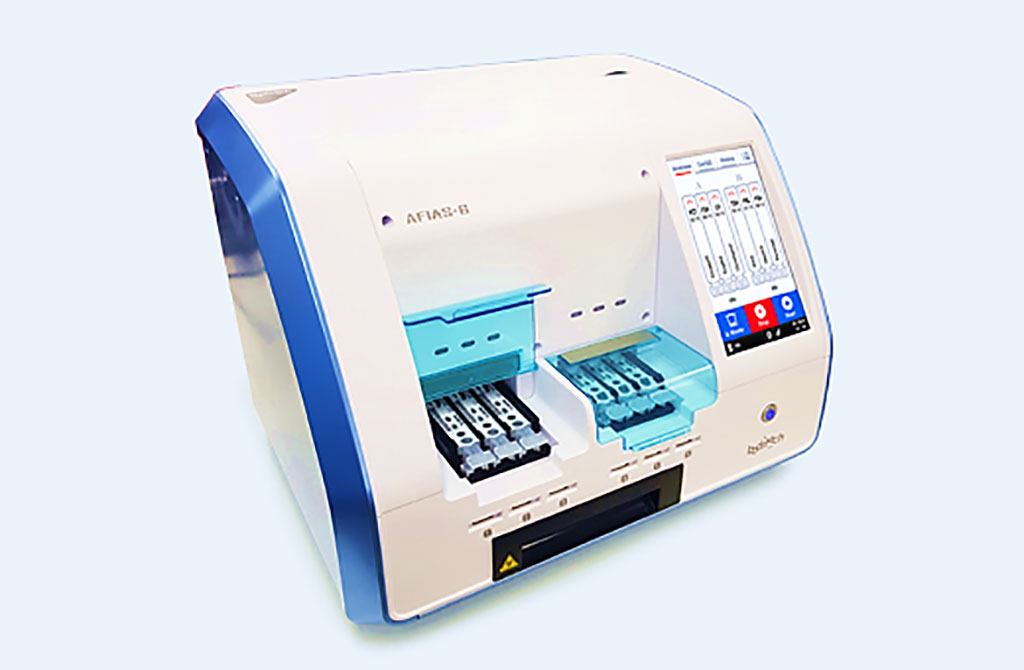New Diagnostic Tests for Rotavirus and Norovirus Infections Evaluated
|
By LabMedica International staff writers Posted on 21 Oct 2020 |

Image: The AFIAS-6 (AFIAS-automated fluorescent immunoassay system) is an automated fluorescent immunoassay system that uses blood, urine, and other samples to measure quantitatively or semi-quantitatively the concentration of targeted analyte (Photo courtesy of Boditech Med Inc).
Acute gastroenteritis is one of the most impactful and common infectious diseases, accounting for millions of deaths annually in young children. Rotavirus and norovirus are leading causes of acute viral gastroenteritis spread through fecal to oral transmission.
For appropriate treatment and infection control, accurate and timely identification of pathogens is necessary. Various diagnostic tools including electron microscopy, latex agglutination, immunochromatographic assay (ICA), enzyme immunoassays, and molecular assays have been developed.
A team of Medical Laboratorians at the Samsung Medical Center (Seoul, Republic of Korea) used a total of 256 clinical stool samples submitted to the clinical microbiology laboratory at a tertiary referral hospital, from November 2018 to January 2019. After routine testing with multiplex real‐time RT‐PCR (rRT‐PCR), residual stool samples were stored at −70 °C prior to analysis.
The team evaluated the performance of Automated Fluorescent Immunoassay System ROTA (AFIAS‐Rota) and NORO (AFIAS‐Noro) assays (Boditech Med Inc, Chuncheon-si, Korea), newly developed automated fluorescent lateral flow immunoassays, in comparison with RIDASCREEN Rotavirus (RIDASCREEN‐Rota) and Norovirus (RIDASCREEN‐Noro) ELISA kits (R‐Biopharm, Darmstadt, Germany) for detection of rotavirus and norovirus. The Boditech assays were read after 12 minutes using that company’s AFIAS‐6 scanner and for the R-Biopharm assays the fluorescence was analyzed using a GEMINI spectrofluorometer (STRATEC Biomedical AG, Birkenfeld, Germany).
The investigators reported AFIAS‐Rota and RIDASCREEN Rotavirus had almost perfect agreement and substantial agreement was observed between AFIAS‐Noro and RIDASCREEN Norovirus. For detection of rotavirus, AFIAS and RIDASCREEN assays showed satisfactory diagnostic sensitivity (100% and 97.8%, respectively) and specificity (99.5% and 99.1%). For detection of norovirus, the RIDASCREEN assay showed significantly higher sensitivity than the AFIAS‐Noro (86.0% and 66.0%, respectively). Analytic specificity of AFIAS‐Rota/Noro assays showed no cross‐reactivity against any other bacteria (14 strains) or viruses (two strains). Hands‐on time (six minutes) and turnaround time (26 minutes) required to perform AFIAS assays were much shorter than those required for RIDASCREEN assays (20 and 150 minutes, respectively).
The authors concluded that the AFIAS‐Rota/Noro assays showed overall excellent agreement with the RIDASCREEN assays. Although the AFIAS‐Noro assay exhibited lower sensitivity than the RIDASCREEN Norovirus assay for detection of norovirus, the AFIAS‐Rota/Noro assays could be useful as a rapid initial screening test in clinical laboratories due to its convenience and rapid turnaround time. The study was published on September 23, 2020 in the Journal of Clinical Laboratory Analysis.
Related Links:
Samsung Medical Center
Boditech Med Inc
R‐Biopharm
STRATEC Biomedical AG
For appropriate treatment and infection control, accurate and timely identification of pathogens is necessary. Various diagnostic tools including electron microscopy, latex agglutination, immunochromatographic assay (ICA), enzyme immunoassays, and molecular assays have been developed.
A team of Medical Laboratorians at the Samsung Medical Center (Seoul, Republic of Korea) used a total of 256 clinical stool samples submitted to the clinical microbiology laboratory at a tertiary referral hospital, from November 2018 to January 2019. After routine testing with multiplex real‐time RT‐PCR (rRT‐PCR), residual stool samples were stored at −70 °C prior to analysis.
The team evaluated the performance of Automated Fluorescent Immunoassay System ROTA (AFIAS‐Rota) and NORO (AFIAS‐Noro) assays (Boditech Med Inc, Chuncheon-si, Korea), newly developed automated fluorescent lateral flow immunoassays, in comparison with RIDASCREEN Rotavirus (RIDASCREEN‐Rota) and Norovirus (RIDASCREEN‐Noro) ELISA kits (R‐Biopharm, Darmstadt, Germany) for detection of rotavirus and norovirus. The Boditech assays were read after 12 minutes using that company’s AFIAS‐6 scanner and for the R-Biopharm assays the fluorescence was analyzed using a GEMINI spectrofluorometer (STRATEC Biomedical AG, Birkenfeld, Germany).
The investigators reported AFIAS‐Rota and RIDASCREEN Rotavirus had almost perfect agreement and substantial agreement was observed between AFIAS‐Noro and RIDASCREEN Norovirus. For detection of rotavirus, AFIAS and RIDASCREEN assays showed satisfactory diagnostic sensitivity (100% and 97.8%, respectively) and specificity (99.5% and 99.1%). For detection of norovirus, the RIDASCREEN assay showed significantly higher sensitivity than the AFIAS‐Noro (86.0% and 66.0%, respectively). Analytic specificity of AFIAS‐Rota/Noro assays showed no cross‐reactivity against any other bacteria (14 strains) or viruses (two strains). Hands‐on time (six minutes) and turnaround time (26 minutes) required to perform AFIAS assays were much shorter than those required for RIDASCREEN assays (20 and 150 minutes, respectively).
The authors concluded that the AFIAS‐Rota/Noro assays showed overall excellent agreement with the RIDASCREEN assays. Although the AFIAS‐Noro assay exhibited lower sensitivity than the RIDASCREEN Norovirus assay for detection of norovirus, the AFIAS‐Rota/Noro assays could be useful as a rapid initial screening test in clinical laboratories due to its convenience and rapid turnaround time. The study was published on September 23, 2020 in the Journal of Clinical Laboratory Analysis.
Related Links:
Samsung Medical Center
Boditech Med Inc
R‐Biopharm
STRATEC Biomedical AG
Latest Immunology News
- Ultrasensitive Liquid Biopsy Demonstrates Efficacy in Predicting Immunotherapy Response
- Blood Test Could Identify Colon Cancer Patients to Benefit from NSAIDs
- Blood Test Could Detect Adverse Immunotherapy Effects
- Routine Blood Test Can Predict Who Benefits Most from CAR T-Cell Therapy
- New Test Distinguishes Vaccine-Induced False Positives from Active HIV Infection
- Gene Signature Test Predicts Response to Key Breast Cancer Treatment
- Chip Captures Cancer Cells from Blood to Help Select Right Breast Cancer Treatment
- Blood-Based Liquid Biopsy Model Analyzes Immunotherapy Effectiveness
- Signature Genes Predict T-Cell Expansion in Cancer Immunotherapy
- Molecular Microscope Diagnostic System Assesses Lung Transplant Rejection
- Blood Test Tracks Treatment Resistance in High-Grade Serous Ovarian Cancer
- Luminescent Probe Measures Immune Cell Activity in Real Time
- Blood-Based Immune Cell Signatures Could Guide Treatment Decisions for Critically Ill Patients
- Novel Tool Predicts Most Effective Multiple Sclerosis Medication for Patients
- Companion Diagnostic Test for CRC Patients Identifies Eligible Treatment Population
- Novel Tool Uses Deep Learning for Precision Cancer Therapy
Channels
Clinical Chemistry
view channel
Compact Raman Imaging System Detects Subtle Tumor Signals
Accurate cancer diagnosis often depends on labor-intensive tissue staining and expert pathological review, which can delay results and limit access to rapid screening. These conventional methods also make... Read more
Noninvasive Blood-Glucose Monitoring to Replace Finger Pricks for Diabetics
People with diabetes often need to measure their blood glucose multiple times a day, most commonly through finger-prick blood tests or implanted sensors. These methods can be painful, inconvenient, and... Read moreMolecular Diagnostics
view channel
Urine Test Could Reveal Real Age and Life Span
Chronological age does not always reflect how quickly the body is aging, as biological age is shaped by genetics, stress, sleep, nutrition, and lifestyle factors such as smoking. A higher biological age... Read more
Genomic Test Identifies African Americans at Risk for Early Prostate Cancer Recurrence
Prostate cancer is one of the most commonly diagnosed cancers in men and a leading cause of cancer-related death, particularly in the United States. African American men face a disproportionately higher... Read moreHematology
view channel
MRD Tests Could Predict Survival in Leukemia Patients
Acute myeloid leukemia is an aggressive blood cancer that disrupts normal blood cell production and often relapses even after intensive treatment. Clinicians currently lack early, reliable markers to predict... Read more
Platelet Activity Blood Test in Middle Age Could Identify Early Alzheimer’s Risk
Early detection of Alzheimer’s disease remains one of the biggest unmet needs in neurology, particularly because the biological changes underlying the disorder begin decades before memory symptoms appear.... Read more
Microvesicles Measurement Could Detect Vascular Injury in Sickle Cell Disease Patients
Assessing disease severity in sickle cell disease (SCD) remains challenging, especially when trying to predict hemolysis, vascular injury, and risk of complications such as vaso-occlusive crises.... Read more
ADLM’s New Coagulation Testing Guidance to Improve Care for Patients on Blood Thinners
Direct oral anticoagulants (DOACs) are one of the most common types of blood thinners. Patients take them to prevent a host of complications that could arise from blood clotting, including stroke, deep... Read moreImmunology
view channel
Ultrasensitive Liquid Biopsy Demonstrates Efficacy in Predicting Immunotherapy Response
Immunotherapy has transformed cancer treatment, but only a small proportion of patients experience lasting benefit, with response rates often remaining between 10% and 20%. Clinicians currently lack reliable... Read more
Blood Test Could Identify Colon Cancer Patients to Benefit from NSAIDs
Colon cancer remains a major cause of cancer-related illness, with many patients facing relapse even after surgery and chemotherapy. Up to 40% of people with stage III disease experience recurrence, highlighting... Read morePathology
view channel
Genetics and AI Improve Diagnosis of Aortic Stenosis
Aortic stenosis is a progressive narrowing of the aortic valve that restricts blood flow from the heart and can be fatal if left untreated. There are currently no medical therapies that can prevent or... Read more
AI Tool Simultaneously Identifies Genetic Mutations and Disease Type
Interpreting genetic test results remains a major challenge in modern medicine, particularly for rare and complex diseases. While existing tools can indicate whether a genetic mutation is harmful, they... Read more
Rapid Low-Cost Tests Can Prevent Child Deaths from Contaminated Medicinal Syrups
Medicinal syrups contaminated with toxic chemicals have caused the deaths of hundreds of children worldwide, exposing a critical gap in how these products are tested before reaching patients.... Read more
Tumor Signals in Saliva and Blood Enable Non-Invasive Monitoring of Head and Neck Cancer
Head and neck cancers are among the most aggressive malignancies worldwide, with nearly 900,000 new cases diagnosed each year. Monitoring these cancers for recurrence or relapse typically relies on tissue... Read moreTechnology
view channel
Pioneering Blood Test Detects Lung Cancer Using Infrared Imaging
Detecting cancer early and tracking how it responds to treatment remains a major challenge, particularly when cancer cells are present in extremely low numbers in the bloodstream. Circulating tumor cells... Read more
AI Predicts Colorectal Cancer Survival Using Clinical and Molecular Features
Colorectal cancer is one of the most common and deadly cancers worldwide, and accurately predicting patient survival remains a major clinical challenge. Traditional prognostic tools often rely on either... Read moreIndustry
view channel
BD and Penn Institute Collaborate to Advance Immunotherapy through Flow Cytometry
BD (Becton, Dickinson and Company, Franklin Lakes, NJ, USA) has entered into a strategic collaboration with the Institute for Immunology and Immune Health (I3H, Philadelphia, PA, USA) at the University... Read more



















